![]()
![]()
![]()
Use LEFT and RIGHT arrow keys to navigate between flashcards;
Use UP and DOWN arrow keys to flip the card;
H to show hint;
A reads text to speech;
169 Cards in this Set
- Front
- Back
|
what is an Acellular virus
|
a virus that has no cytoplasmic membrane, no functional organelles DNA or RNA with a protein coat (capsid) and/or envelope |
|
|
what is a virion
|
virus outside of a host cell |
|
|
what is Nucleocapsid
|
Nucleic acid and capsid |
|
|
what is a virus envelope
|
…phospholipid membrane in some viruses, covers the nucleocapsid |
|
|
can a negative sense ssRNA use the ribosme?
|
no
|
|
|
RNA transcriptase |
the enzyme that viruses use when they have negative sense ssRNA , to converted it into positive sense RNA |
|
|
viral genetic material can be ss or ds what does that mean
|
ss is single stranded ds is double stranded |
|
|
virus surface protiens attach to what in the host
|
glycoprotiens |
|
|
HIV has surface proteins specific only to
|
T helper cells
|
|
|
what is a bacteriophage
|
a bacteria virus |
|
|
what are capsomeres
|
monomer subunits of capsid |
|
|
what are the viral shapes
|
helical polyhedral complex |
|
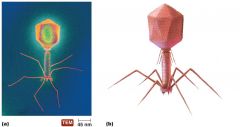
what is this?
|
a t4 virus
|
|
|
Envelope of a virus is
|
a portion of the membrane system of a host cell … phopholipid bilayer and proteins
|
|
|
International Committee on Taxonomy of Viruses has 4 classifications for a virus, what are they |
…Type of nucleic acid … Presence of envelope … Shape … Size |
|
|
what happens in the Lytic Replication Cycle
|
use the host’s enzymes and organelles to make copies of the virus … then burst open the host cell
|
|
|
what are the steps of the Lytic Replication Cycle
|
…Attachment …Entry …Synthesis …Assembly …Release of virions by lysis |
|
|
What is Lysogeny
|
Infected cells grow and reproduce normally for many generations before they lyse
|
|
|
animal viruses don't have tails and tail fibers, what do they have?
|
they have glycoprotein spikes |
|
|
what are the three mechanisms of entry for animal viruses
|
1. Penetration- A process by in which the viral capsid attaches and sinks into the cytoplasmic membrane creating a pore through which the genome alone enters the cell. |
|
|
litmus milk protein is
|
casein
|
|
|
the carbohydrate in litmus milk is
|
lactose |
|
|
the litmus milk indicator is
|
litmus
|
|
|
what are the results that you can expect from a litmus milk test |
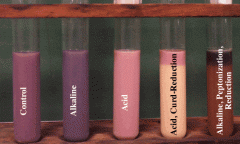
|
|
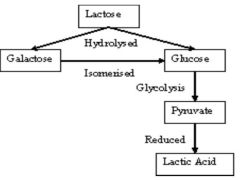
what is this ?
|
lactose fermentation
|
|
|
what gasses may be formed in a litmus milk test and how do you know they are formed
|
it makes hard to see fissures or cracks in the curd |
|

what are the results seen here in the litmus milk test
|
A. Acid/Reduction/Curd
B. Reduction/Curd (arrow denotes gas pocket) C. UninoculatedControl D. Acid Formation E. Proteolysis of casein F. Alkaline Reaction |
|
|
how do tell if there is a reduction of the litmus indicator
|
a white precipitate is formed at the end of the tube |
|
|
if you break down casein into amino acids you get
|
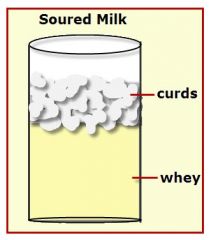
curds and whey and alkaline pH |
|
|
Peptonization |
Completely hydrolyze casein to amino acids |
|
|
ropiness in the litmus milk test is a found when |
is found when curd is not all the way formed yet |
|
|
herpesviridae name the strand type and the disease |
causes the simplexvirus ( herpes 1 and 2 ) varicellovirus ( chicken pox) |
|
|
name the strand type and the disease |
double strand orthopoxvitus ( small pox) |
|
|
papillomaviridae name the strand type and the disease |
that causes papillomavirus ( benign tumors, warts, cervical and penile cancers ) |
|
|
Explain synthesis of Positive-Sense ssrna virus for the genome in animal viruses |
Positive-Sense ssrna virus- single stranded viral RNA that can directly act as mRNA. A complementary negative strand RNA is transcribed from the +ssRNA genome by viral RNA polymerase; -RNA then serves as the template for the transcription of multiple +ssRNA genomes. |
|
|
Explain synthesis of Retroviruses for the genome in animal viruses |
Retroviruses- Unlike other +ssRNA viruses, the +ssRNA viruses called retroviruses do not use their genome as mRNA. Instead, retroviruses use a DNA intermediary that is transcribed from +RNA by reverse transcriptase carried within the capsid. This DNA intermediary then serves as the template for the synthesis of additional +RNA molecules which act both as mRNA for protein synthesis and as genomes for new virons. |
|
|
Explain synthesis of Negative-Sense ssRNA Viruses for the genome in animal viruses |
Negative-Sense ssRNA Viruses- RNA dependent RNA transcriptase which is released into the host cells cytoplasm during uncoating and then transcribes +RNA molecules from the virus's -RNA genome. Translation of proteins can then occur as usual. The newly transcribed +RNA also serves as a template for transcription of additional copies of -RNA. |
|
|
Explain synthesis of Double Stranded RNA virus for the genome in animal viruses
|
Double Stranded RNA virus- unwinds so that each strand serves as a template for its complement.
|
|
|
Explain the differences between bacteriophage replication and animal virus replication. Describe some reasons for these differences |
Have the same five basic steps in their replication pathways as bacteriophages- that is attachment, entry, synthesis, assembly, and release. However there are significant differences in the replication of animal viruses that result in part from the presence of envelopes around some of the viruses & their lack of a cell wall.
-Unlike the bacteriphages we have examined animal viruses lack both tails and tail fibers. Instead animal viruses typically have glycoprotein spikes or other attachment molecules on their capsids or envelopes |
|
|
Distinguish between viruses and living organisms.
|
1. A virus is a minuscule, acellular, infectious agent usually having one or several peices of nucleic acid either DNA or RNA
2. Do not have a cytoplasmic membrane and lack a cytosol with functional organelles 3. Not capable of metabolic activity on their own, instead they must invade a cell, take control of the cell's metabolic machinery to produce more molecules of viral nucleic acid and viral proteins, which then assemble into new viruses 4. Cannot metabolize, grow, self reproduce, or respond to their environment 5. Genetic variety when it comes to their genome. The genome of viruses can be either DNA or RNA as well as in the shape of the genome and is smaller than cells |
|
|
what is the Capsid Morphology of a virus
|
The capsid of a virus is composed of proteinacceous subunits called capsomers and these capsomeres can be composed of a single type of protein or several different kinds of proteins
|
|
|
What enzyme is needed by RNA viruses (not including retroviruses) to replicate their genome?
|
RNA transcriptase
|
|
|
Name the enzyme all retroviruses must package in the virus particle
|
Reverse transcriptase
|
|
|
Latentvirus (provirus)
|
virus that has the ability to stay dormant and symptoms appear later |
|
|
Proto-oncogene
|
A normal gene which, when altered by mutation, becomes an oncogene that can contribute to cancer
|
|
|
what is budding |
Enveloped viruses are often released in a process called budding … assembled virion extruded through host membrane |
|
|
oncogenes
|
a gene that in certain circumstances can transform a cell into a tumor cell, and cause cancer
|
|
|
The role of viruses in cancer |
1cancer cells begin to divide uncontrollably which is called neoplasia. A mass of neoplastic cells is called a tumor. Benign tumors remain in one place. Malignant tumors grow. Protooncogenes are genes that play a role in cell division. As long a protooncogenes are repressed no cancer results. However actiivity of oncogenes or inactivation of oncogene repressors can cause cancer to develop. |
|
|
what is a viroid
|
smallest infectious pathogens known, consisting solely of short strands of circular, single-stranded RNA without protein coats, no capsid They are mostly plant pathogens
|
|
|
what is a prion
|
a misfolded protein
|
|
|
what is the indicator in SIM agar |
cysteineferrous ammonium sulfate indicator
|
|
|
Explain synthesis of Positive-Sense ssrna virus for the genome in animal viruses |
Positive-Sense ssrna virus- single stranded viral RNA that can directly act as mRNA. A complementary negative strand RNA is transcribed from the +ssRNA genome by viral RNA polymerase; -RNA then serves as the template for the transcription of multiple +ssRNA genomes. |
|
|
what do you test for with SIM agar
|
H2S production Indole motility |
|
|
what does lipase do
|
Lipase breaks down lipids |
|
|
What is a Triglyceride
|
glycerol and three fatty acids
|
|
|
phospholipid
|
glycerol, 2 fatty acids, and a phosphate group
|
|
|
Lipase break down triglycerides into glycerol and fatty acids … yielding what kind of medium? |
an acidic medium |
|
|
how do you test for lipase
|
spirit blue agar
|
|
|
describe spirit blue agar and the results you would see
|
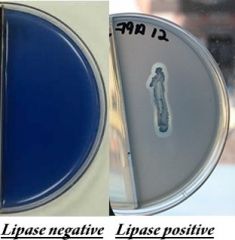
Contains lipids Spirit blue dye binds to lipids so if there is a breakdown of lipids … no dye is present |
|
|
what is the enzyme that breaks down DNA
|
Deoxyribonuclease |
|
|
what does DNase Test Agar contain |
DNA
|
|
|
describe what happens in the DNase test agar and what you will see
|

-Small DNA and DNA break down productswill not precipitate when HCl is added to the plate … will see a cleararea if bacteria produces DNase |
|
|
what is cysteine |
an amino acid
|
|
|
|
viridans streptococci
|
|
|
what parts of the GI are almost free of microbes
|
Esophagus,stomach, duodenum
|
|
|
where do microorganisms colonize in the GI
|
the tongue, teeth, mouth,pharynx, jejunum, ileum, colon, and rectum |
|
|
how much of fecal mass is bacteria
|
40% |
|
|
how do normal GI micro biota protect the body |
by outcompeting pathogens |
|
|
how much gas an bacterial produce daily
|
500 ml a day |
|
|
Obese people have more Gram-posbacteria which means they can do what |
that breakdown indigestible polysaccharides into sugars that can beabsorbed |
|
|
what do dental caries begin with
|
Streptococcus mutans |
|
|
what is dental plaque
|
a biofilm |
|
|
what is tartar
|
hard deposits caused when calcium salts mineralize plaque |
|
|
Tartartrapped at the base of teeth will lead to
|
periodontal disease … gingivitis |
|
|
Bacteriacan invade the surrounding bone causing
|
osteomyelitis |
|
|
causative agent in PepticUlcer Disease |
Helicobacter pylori
|
|
|
what is
BacterialGastroenteritis |
Inflammation of stomach or intestinescaused by pathogenic bacteria |
|
|
what is dysentery |
loose bloody stools |
|
|
what are the causative agents of Shigellosis |
Shigelladysenteriae,S. flexneri,S. boydii,S. sonnei |
|
|
what is a type 3 secretion system
|
proteins that insert into the host cellmembrane and form a channel … allowing bacterial proteins to enter host cell |
|
|
causative agent in traveler's diarrgea
|
e. coli, virulent strains
|
|
|
causative agent in
Campylobacter Diarrhea |
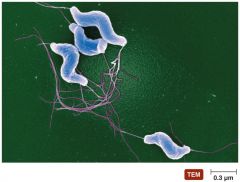
Campylobactorjejuni
|
|
|
causative agent in C. Diff. diarrhea
|
Clostridium difficile
|
|
|
Clostridium difficile mayl ead to a life threating condition called
|

pseudomembranous colitis
|
|
|
Antimicrobial Associated Diarrhea
|
When antimicrobials kill off goodbacteria, C.diff. endosporesgenerate |
|
|
causative agent in
Salmonellosis and Typhoid Fever |
Salmonella enterica
|
|
|
causative agent in Cholera
|
Vibrio cholera
|
|
|
what is the most common sign of cholera
|
rice water stools |
|
|
what is the causative agent of bacterial food poisoning
|
Staphylococcus aureus
|
|
|
causative agent in oral herpes
|
Human herpesvirus
|
|
|
where does the Human herpesvirus eventually establish infections
|
trigeminal nerve ganglion |
|
|
causative agent if mumps
|
Rubulavirus
|
|
|
causative agent of
Viral Gastroenteritis |
Norovirus…consumption of contaminated food or water Rotavirus … fecal-oral route from contaminated food or water |
|
|
what shape are the norovirus and the rotavirus
|

Norovirus … star shaped capsids Rotavirus … wheel like shape |
|
|
what are the causative agents of viral hepatitis
|
hep A virus hep B virus hep C virus Hep D virus Hep E virus |
|
|
what is jaundice |
yellowing of the skin related to a build up of bilirubin |
|
|
types of hepatitis are usually cleared by the immune system
|
hep A and E
|
|
|
what hepatitis causes Dane particles
|

Hep B
|
|
|
causative agent of Giardiasis
|
Giardia intestinalis
|
|
|
causative agent of Cryptosporidiosis |
Cryptosporidium parvum
|
|
|
what is a Sporozoite
|
banana shaped motile infectious form -- willthen form thick shelled oocysts |
|
|
causative agent of Amebiasis
|
Entamoeba histolytica
|
|
|
what is a helminthic
|
a flat worm |
|
|
what is the causative agent of
Tapeworms… Cestode |
Taenia saginata… Taeniasolium
|
|
|
causative agent of pinworms
|
Enterobiusvermicularis
|
|
|
causative agent of nematode
|
Anisakis simplex
|
|
|
|
|
|
|
|
|
|
|
|
|
|
|
|
|
|
|
|
|
|
|
|
|
|
|
|
|
|
|
|
|
|
|
|
|
|
|
|
|
|
|
|
|
|
|
|
|
|
|
|
|
|
|
|
|
|
|
|
|
|
|
|
|
|
|
|
|
|
|
|
|
|
|
|
|
|
|
|
|
|
|
|
|
|
|
|
|
|
|
|
|
|
|
|
|
|
|
|
|
|
|
|
|
|
|
|
|
|
|
|
|
|
|
Koch’sPostulates
|
germ theory of disease
|
|
|
explain koch's postulates
|
… Suspected agent must be present inevery case of the disease … Agent must be isolated and grown inpure culture … Cultured agent must cause the diseasewhen it is inoculated into a healthy, susceptible experimental host … Same agent must be reioslated fromthe diseased experimental host |
|
|
what are the exceptions to Koch's postulates
|
… Mycobacterium leprae… hasnever been grown on laboratory medium … Some diseases caused by a combo ofpathogens … Probably not a good idea to inoculate ahealthy susceptible host |
|
|
Pathogenicity
|
-ability of microbe to cause disease |
|
|
virulence
|
-degree of pathogencity |
|
|
what are the virulence factors
|
ability to enter host, adhere to hostcells, gain access to nutrients, escape detection of immune system |
|
|
what does the botulism toxin do
|
|
|
|
what does the tetnous toxin do |
|
|
|
Exotoxins
|
destroy host cells or interfere with hostmetabolism |
|
|
Cytotoxins
|
kill host cell
|
|
|
Neurotoxins
|
interfere with nerve cell function |
|
|
Enterotoxins
|
affects cells in the GI |
|
|
Exotoxins
|
destroy host cells or interfere with hostmetabolism |
|
|
Antitoxins
|
…neutralize the toxin … could be antibodies
|
|
|
Antiphagocyticfactors |
bacterial capsule Antiphagocytic chemicals - prevent formation of phagolysome inhibit phagocytosis- example m- proteins on the cell wall leukocidins - destroy phagocytes |
|
|
Incubation
|
time between infection and signs /symptoms |
|
|
Prodromal
|
short period of mild symptoms thatprecedes illness |
|
|
Illness
|
immune system has not fully responded …that’s when you go to the doctor |
|
|
Decline
|
immune system is getting rid of thepathogens |
|
|
Convalescence
|
tissue repair |
|
|
what are the 5 stages of infectious disease
|
incubation prodromal illness decline convalesence |
|
|
what is an example of a biological vector
|
biting arthropods |
|
|
what is a mechanical vector
|
doesn't require a host.. just carries the pathogen
|
|
|
what are the classifications of infectious diseases
|
-Acute -Chronic -Latent … -Communicable disease -Contagious … -Noncommunicabledisease … |
|
|
Incidence
|
number of new cases of a disease in agiven area or population during given period of time |
|
|
Prevalence
|
total number of cases |
|
|
Endemic
|
relatively stable incidence within a givenpopulation |
|
|
Sporadic
|
few scattered cases |
|
|
Epidemic
|
greaterfrequency than usual
|
|
|
Pandemic
|
epidemic occurs simultaneously on morethan one continent |
|
|
NationallyNotifiableInfectious Diseases
|
got to report these to the CDC |
|
|
AnalyticalEpidemiology
|
lookat the data
|
|
|
ExperimentalEpidemiology
|
hypothesistesting of cause of a disease
|
|
|
Innate
|
you are born with it |
|
|
what kind of cells do you find on the Epidermis
|
Dendritic phagocyticcells
|

